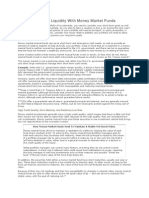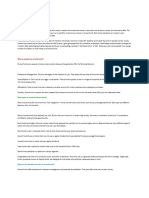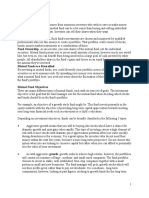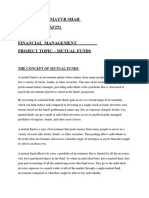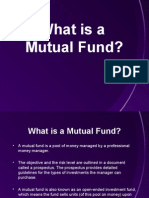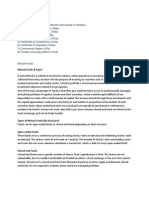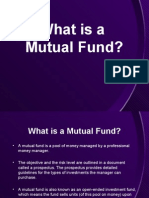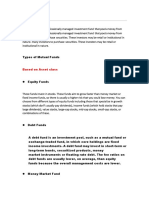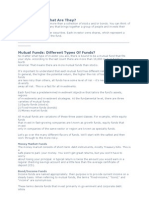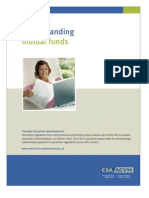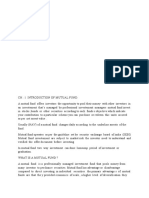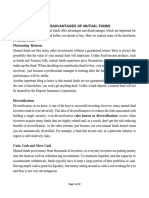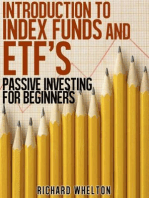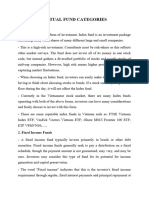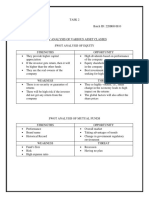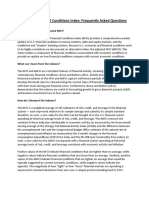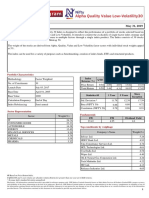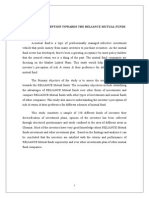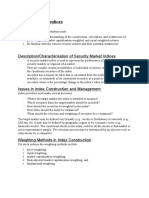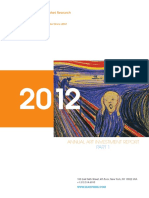Start With Mutual Funds: Prospectus
Start With Mutual Funds: Prospectus
Uploaded by
rajuttanCopyright:
Available Formats
Start With Mutual Funds: Prospectus
Start With Mutual Funds: Prospectus
Uploaded by
rajuttanOriginal Title
Copyright
Available Formats
Share this document
Did you find this document useful?
Is this content inappropriate?
Copyright:
Available Formats
Start With Mutual Funds: Prospectus
Start With Mutual Funds: Prospectus
Uploaded by
rajuttanCopyright:
Available Formats
MM-01-00
A mutual fund is an investment company that collects money from many people and invests it in a variety of securities. The company then manages the money on an ongoing basis for individuals and businesses. Mutual funds are an efficient way to invest in stocks, bonds, and other securities for three reasons: 1. The securities purchased are managed by professional managers. 2. Risk is spread out or diversified, because you have a collection of different stocks and bonds. 3. Costs usually are lower than what you would pay on your own, since the fund buys in large quantities. The combined stocks, bonds, and securities of a fund are known as its portfolio. Each investor owns shares, which represent a part of the holdings in the total portfolio. Usually, investment companies have a variety of funds to sell. Examples of investment companies include Vanguard, Fidelity, Janus, T. Rowe Price, American Funds, and Dreyfus. These and other companies have many mutual funds with different investment objectives. Mutual funds can be bought directly from the investment company or from brokers, banks, financial planners, or insurance agents.
Before purchasing any fund: Know the types of funds available. Read the funds prospectus. Study the funds fee table. Consider the funds objective and your investment objectives. Consider the other investments you have. Know the funds performance. Read other financial information about funds you are considering.
Three Ways You Can Make Money on Mutual Funds
1. Dividends and Interest. A fund may receive income in the form of dividends and interests on the securities it owns. Bonds pay interest, and some stocks pay dividends. The mutual fund company will pass this income on to its shareholders. You generally will be taxed yearly on this amount unless the fund holds taxfree securities. 2. Capital Gains/Losses on Securities in a Fund. Prices of the securities in a fund may increase. When the fund then sells the security, the fund has a capital gain. At the end of the year, most mutual funds will distribute these capital gains minus any capital losses (reduced price) to the investors. These capital gains will be taxed each year they are received.
3. Net Asset Value (NAV) of the Mutual Fund. If the company does not sell but holds securities that have increased in value, the value of the shares of the mutual fund (NAV) increase and there is a profit. This also is a capital gain. However, you will not be taxed on this capital gain until the year you sell the fund.
Objectives of Mutual Funds
1. Income. Income funds focus on dividends and interest that provide income to investors. This is a relatively steady source of money, but the funds NAV can still go up and down. 2. Growth. Growth funds focus on increasing the value of the principal or amount invested through capital gains and net asset values. Growth funds are usually more risky but offer greater potential return.
This fact sheet is intended for educational purposes only. Mention of a proprietary product, trademark or commercial firm in text or figures does not constitute endorsement by Ohio State University Extension and does not imply approval to the exclusion of other products or firms. For specific advice, consult your financial or legal advisor.
FUN D TUAL U
Start with Mutual Funds
e Prosp
ctus
3. Stability. Stability funds focus on protecting the amount invested from loss so the funds NAV does not go down. This is the least risky type of fund but may make the least amount of money.
Types of Mutual Funds
Various types of mutual funds are available. These types are based on general categories of securities held in the funds. Money Market Funds have relatively low risks compared to other mutual funds. They are limited by law to certain high-quality, short-term investments. Money market funds try to keep their value (NAV) at a stable $1 per share, but it can fall below that if the investments do poorly. Losses are rare, but possible. Their objective is stability of the fund. Dont confuse a money market fund with a money market deposit account. Banks have money market deposit accounts that are like a savings account and are insured by the Federal Deposit Insurance Corporation (FDIC). This is different from a mutual fund money market. The mutual fund owns other securities and its value is based on their performance. A money market deposit account is not a mutual fund. Banks may sell either or both, so be sure you know which type of money market you are getting. Bond/Fixed Income Funds have higher risks than money market funds, but seek to pay more income than money market funds. Bond funds are not limited to high-quality or short-term investments, so they can vary dramatically in their risks and rewards. Because interest rates vary, the market value of bonds can rise and fall, so you can lose money in any bond fund. The longer the term of the bonds in the fund, the more risky the fund. Likewise, uninsured bond funds are more risky than insured bond funds. Bond funds rated below BBB are considered risky.
Equity/Stock Funds involve more risk than money market or bond funds but offer the highest potential returns. Usually, these funds focus on growth of capital gains and not so much on size of dividends paid. When the funds objective is minimal to no income, it is considered an aggressive growth fund. A stock funds value (NAV) can rise or fall rapidly over a short time, but historically stocks have outperformed other types of investments over the long term. A longer time periodat least five to ten yearsis needed for this investment objective. Aggressive growth funds are classified as very high risk and should be considered as an investment for longer than a ten-year period. Balanced Funds contain a mixture of stocks and bonds. This type of fund is a good beginning investment because it diversifies the portfolio with both stocks and bonds. Because stocks and bonds sometimes move in opposite directions (when stocks go up, bonds go down), this keeps a more even and less volatile portfolio. These funds combine objectives of conserving principal, paying current income, and promoting long-term growth of capital. In addition to the four broad mutual funds categories already described, there are several specialty mutual funds:
International/Global Mutual Funds invest in securities outside the United States or invest in both foreign and United States stocks. International funds are subject to currency risk or gain as well as a higher expense ratio. Sector funds specialize in certain markets, such as health care, technology, or precious metals. Affinity funds have emerged to reflect an investors political or environmental concerns. Index funds attempt to hold the individual securities in major indexes such as The Dow Jones Industrial Average or the S&P 500. Asset-Allocation funds, a newer type of mutual fund, are a blend of stocks, bonds, and money market funds directed to the investors risk tolerance. For example, a more aggressive assetallocation fund invests 75 to 100 percent in common stocks and 25 percent in bonds, while a moderate risk asset-allocation fund invests 25 percent in stocks, 25 percent in money markets, and 50 percent in long-term bonds. A conservative asset-allocation portfolio is made up of money market funds and short-term or intermediate-term bonds with few or no stocks. Fund of Funds, another new type of mutual fund, is a combination of funds. There may be a stock fund, a bond fund or a money fund combined to provide
WA L L S T R E E T
diversification. Be cautious because there are fees for the separate funds plus fees for the actual fund you are purchasing.
Reading a Mutual Fund Prospectus/Profile
Request a prospectus as well as a profile. The company must update the prospectus yearly. Check the fund objective to see if it matches your investment objective. Find the minimum investment needed. If the minimum amount is more than you have to invest, you can rule out the fund quickly. Examine investment risk. Does it match yours? How much risk are you willing to assume? If the funds NAV goes down, will you hold it until it goes up again? Review the chart with summary of expenses. Compare the cost of investing $10,000 at 5 percent over one-, three-, five-, and ten-year periods and selling at the end of each period. This chart allows a standard for comparing two or more funds. Examine the best and worst returns for a quarter. Review the financial history chart. Compare past performance to total market performance or an index that is comparable to the fund. Examine the statement of fund organization. How long has the fund been in business? How large is it? Very large funds are more difficult to manage. Review shareholder services. Can you invest by telephone, mail, the Internet, exchange, or wire? Can you invest automatically each month from your checking account? How are earnings distributed? What is the minimum amount you must keep in your account?1 According to the U.S. Securities and Exchange Commission: A funds past performance is not as important as you might think. Advertisements, rankings, and ratings tell you how well a fund has performed in the
Selecting a Fund
Find funds that match your investment objectives. Consider those funds rated in the top half of all mutual funds within the past 3-5 years. Compare a specific type of mutual fund to others in that same category. Study personal finance magazines to become familiar with investment and financial jargon, key concepts, and the way information is presented. Examples include Kiplingers Personal Finance Magazine, Money, Smart Money, Consumer Reports, Business Week, and Barrons. Look for mutual funds that match your targeted fund category and investment objectives and have consistent returns, good past performance, and low fee structures. Determine how long the fund manager has managed the fund. Find an 800 number for the fund and request the most recent prospectus or look on the Internet. To narrow your search, go to the library or visit a stockbroker to use mutual fund reference books for more in-depth information. Such resources might include Wiesenberger Investment Company Service, Morningstars Mutual Funds, The Value Line Investment Reports, The Value Line No-Load Fund Advisor, or Mutual Fund Profiles. Track the funds performance in a daily newspaper with extensive financial pages or on the Internet. Be careful about investing before a capital gains or dividend/interest distribution particularly at the end of the year. Consider the risks associated with the fund.
past. But studies show that the future is often different. This years No. 1 fund can easily become next years below-average fund. (Note: Although past performance is not a reliable indicator of future performance, volatility of past returns is a good indicator of a funds future volatility.)2
Mutual Fund Volatility
In stock funds, volatility is measured by Beta. In bond funds, volatility is best determined by bond maturity. Bonds maturing in thirty years have more volatility than bonds maturing in five or ten years. For stock funds, the Beta number tells how volatile the fund is compared to the overall stock market. When the Beta is 1.00, the fund moves at the same rate as a comparable index, such as the S&P 500. When the Beta is .85, the fund will only rise 85 percent of the index, but it also falls only 85 percent as much as the index. When the Beta is 1.15, the fund will move 115 percent compared to its index, so there will be a larger gain but also a greater risk of losing more money than a comparable index. Research reports, like Morningstar, provide Beta.
Current Mutual Fund Fees
Mutual fund fees are reported in the prospectus or fund profile which can be obtained from a broker or investment company. The following sections report current fees. Front-End Loads or Sales Charges Range 0 to 8.5 Percent. This commission fee is paid for the initial investment and can range from 0 percent to 8.5 percent. The broker who selects and sells you the fund
1
Adapted from: Patricia M. Tengel. Mutual Funds Fact Sheet. University of Maryland Cooperative Extension Service.
2
Securities and Exchange Commission, Invest Wisely, An Introduction to Mutual Funds: Advice from the U.S. Securities and Exchange Commission, Washington, D.C., 1996.
may receive a portion of this fee. Check for charges on dividends that are reinvested in the fund automatically. Back-End Loads, Redemption Fees, and Exit FeesRange 0 to 6 Percent. Some funds charge when you sell a fund soon after purchase. These loads will typically decline with each year you own the fund and disappear after you own it for a number of years. 12b-1 or Marketing FeesRange 0 to .75 Percent. The U.S. Securities and Exchange Commission allows mutual funds to charge what is known as the 12b-1 fee to cover marketing and distribution costs. These fees are taken from the funds assets each year. A mutual fund with a load can charge .75% of average net costs per year, while a no load fund can charge .25% per year. Management and Administrative Fees Range .2 to 2.5 Percent. All funds charge investors a management or administration fee that is a percentage of the total investment each year. These fees average 1.4 percent, typically with stock funds higher and bond funds lower.
funds with different fees to determine how much the different fees will cost you. Which Fees Are the Best? Consider the yearly costs carefully. Over a long time period these fees will add up, so look for funds with low yearly fees. If you are sure the price will go up, then the front-end fee may be best if you plan to pull out in a few years and you have compared this option with a back-end load. The fee table will make it easier to compare funds. However, a fund that has a higher fee may make you more money than a fund with a lower fee. Determine how much risk you are willing to assume for the higher fee and maybe higher return.
fund that performs well. Therefore, read the prospectuses and select a fund very carefully before investing. You need to consider your needs and your willingness to take risks. For Additional Information Ohio Division of Securities 1-800-788-1194 www. securities.state.oh.us/
U.S. Securities and Exchange Commission 450 Fifth Street NW Washington, DC 20549 202-942-7040, www.sec.gov Investing for Your Future www.investing.rutgers.edu or contact your local extension office Mutual Funds Education Alliance www.mfea.com Alliance for Investor Educator www.investoreducation.org
Other Considerations
Total Return. Measures the performance of the mutual fund with all income and capital gain distributions reinvested back into the fund. It also includes the change in the NAV but does not include any of the sale charges. Record Keeping. Once you purchase a mutual fund, keep all the end-ofthe-year statements from the company. Also keep the confirmations of all of your purchases. These will be needed when you sell the fund. It also is helpful to keep a copy of the prospectus and most recent annual report in your file. Notes from conversations with your broker should also be kept.
Originally published by Penn State Cooperative Extension. Written by: Ruth Anne Mears, Ph.D., C.F .P., County Extension Director, Clarion County, in consultation with Marilyn M. Furry, Ph.D., Associate Professor of Extension Education at The Pennsylvania State University, 1998. Adapted with permission for use by Ohio State University Extension, by Ruth Anne Mears, Ph.D., C.F Ex.P., tension Agent, Family and Consumer Sciences, Licking County, July 2000.
Visit Ohio State University Extensions WWW site Ohioline at: http://ohioline.ag.ohio-state.edu
All educational programs conducted by Ohio State University Extension are available to clientele on a nondiscriminatory basis without regard to race, color, creed, religion, sexual orientation, national origin, gender, age, disability or Vietnamera veteran status. Keith L. Smith, Associate Vice President for Ag. Adm. and Director, OSU Extension Hearing impaired readers may request information about educational topics by calling TDD #1-800-589-8292 (in Ohio) or 1-614-292-1868 (outside Ohio). For those with physical disabilities, special arrangements for participating in educational programs can be made by contacting 1614-472-0810.
Total Expenses
Total Fund Operating Expenses. This is a total of all the funds annual costs the bottom line, so to speak. Other fees to look for include maximum sales charges on reinvested dividends and exchange fees (per transaction), charges for switching from one fund to another in the same family. Hypothetical Example: Each fee table ends with an example showing how much of your investment would go to expenses over one, three, five, and ten years. Each fund assumes a $10,000 investment and a 5 percent return each year and that you sell your shares at the end of the time period. This allows you to compare
Summary
Since there are thousands of mutual funds, careful examination before purchasing and at least yearly monitoring of the funds performance are necessary. Mutual funds are an excellent first investment. Remember that the stock market does go up and down and a long-term perspective is needed. Changing from one mutual fund to another is costly and not as productive as buying and holding a
You might also like
- Money Market ConceptsDocument3 pagesMoney Market ConceptsSubhasish DasNo ratings yet
- MUTUAL FUND-assignmentDocument4 pagesMUTUAL FUND-assignmentTinkuNo ratings yet
- Tradebulls Report-FinalDocument74 pagesTradebulls Report-FinalNayan AswaniNo ratings yet
- Week 13-14: Chapter 9: Investing For The Future: Growing Your Financial ResourcesDocument36 pagesWeek 13-14: Chapter 9: Investing For The Future: Growing Your Financial ResourcesGiselle Bronda CastañedaNo ratings yet
- Advantages of Mutual FundsDocument7 pagesAdvantages of Mutual FundsSiri PadmaNo ratings yet
- Mutual Funds: Dividends Interest Capital GainDocument18 pagesMutual Funds: Dividends Interest Capital GainNitish KhuranaNo ratings yet
- Investing in Mutual FundsDocument2 pagesInvesting in Mutual Fundsstavros7No ratings yet
- Mutual FundssssDocument4 pagesMutual FundssssANCHAL SINGHNo ratings yet
- Mutual Fund-WPS OfficeDocument4 pagesMutual Fund-WPS Officesheetalmundada1803No ratings yet
- Preeti (Mutual Fund)Document21 pagesPreeti (Mutual Fund)gawadshrutikaNo ratings yet
- 70517-0310 Mutual FundsDocument16 pages70517-0310 Mutual FundsRaman BuiucliNo ratings yet
- 1.1 Introduction To The TopicDocument92 pages1.1 Introduction To The TopicNithya Devi ANo ratings yet
- Mutual Funds: A Brief History of The Mutual FundDocument9 pagesMutual Funds: A Brief History of The Mutual FundthulasikNo ratings yet
- Stocks and BondsDocument20 pagesStocks and BondsChristian CorchilNo ratings yet
- Fund Advantages and DisadvantagesDocument12 pagesFund Advantages and Disadvantagesratnesh_bth5776No ratings yet
- Money Market Funds: Government BondsDocument5 pagesMoney Market Funds: Government BondsKRUPALI RAIYANINo ratings yet
- Financial Stuff (More Complete)Document24 pagesFinancial Stuff (More Complete)jeff_airwalker23No ratings yet
- What Is A Mutual Fund?Document6 pagesWhat Is A Mutual Fund?vanajaNo ratings yet
- Mutual Funds LearnDocument9 pagesMutual Funds LearnfujimukazuNo ratings yet
- Mutual Fund Notes For B.COM IV Sem Section-ADocument7 pagesMutual Fund Notes For B.COM IV Sem Section-Autkarsh sinhaNo ratings yet
- Mutual Funds111 1Document13 pagesMutual Funds111 1Maknojia RashminNo ratings yet
- Htbaf060 Shreyans Doshi Financial ManagementDocument16 pagesHtbaf060 Shreyans Doshi Financial ManagementTanvi ShahNo ratings yet
- What Is A Mutual Fund?Document14 pagesWhat Is A Mutual Fund?Atif RehmanNo ratings yet
- Mutual Funds & TypesDocument6 pagesMutual Funds & TypesemrangiftNo ratings yet
- 2nd Assignment of Mutual FundDocument16 pages2nd Assignment of Mutual FundLaxmi MulchandaniNo ratings yet
- Money Managers Capital Gains or Income For The Fund's InvestorsDocument9 pagesMoney Managers Capital Gains or Income For The Fund's InvestorsKrishnan UnniNo ratings yet
- What Is A Mutual Fund?Document14 pagesWhat Is A Mutual Fund?mehul_einstein100% (8)
- Mutual FundsDocument13 pagesMutual FundsMuhammad SeyamNo ratings yet
- Welcome To The Mutual Funds Resource CenterDocument6 pagesWelcome To The Mutual Funds Resource CentersivaranjinirathinamNo ratings yet
- Mutual Fund: Based On Asset ClassDocument13 pagesMutual Fund: Based On Asset Classchandan chNo ratings yet
- Low Risk InvestmentsDocument6 pagesLow Risk Investmentsmyschool90No ratings yet
- MF AsddDocument6 pagesMF Asdddarshan0555No ratings yet
- Mutual Funds: What You Need To KnowDocument20 pagesMutual Funds: What You Need To Knowsuraj.ad20018003No ratings yet
- Mutual FundDocument4 pagesMutual FundVandita KhudiaNo ratings yet
- Res Mutual-Funds enDocument13 pagesRes Mutual-Funds enRyan ArdyansyahNo ratings yet
- Risk Return Analysis of Mutual FundsDocument23 pagesRisk Return Analysis of Mutual FundsAnand Mishra100% (1)
- Mutual Fund Investor's PerceptionDocument28 pagesMutual Fund Investor's Perceptionamit royNo ratings yet
- Types of FundsDocument5 pagesTypes of FundsandandanNo ratings yet
- Financial Services NotesDocument13 pagesFinancial Services NotesPunam PandeyNo ratings yet
- What Are Mutual Funds?Document2 pagesWhat Are Mutual Funds?Pranita MandlekarNo ratings yet
- Mutual FundsDocument33 pagesMutual FundsGalijang ShampangNo ratings yet
- 22 Investments 6Document22 pages22 Investments 6Nikhil BhavsarNo ratings yet
- Res Mutual-Funds enDocument13 pagesRes Mutual-Funds enghjkl927No ratings yet
- WWW Investopedia Com Equity Funds Vs Income Funds 8612541Document11 pagesWWW Investopedia Com Equity Funds Vs Income Funds 8612541Ron TraskNo ratings yet
- What Is A Mutual Fund?Document6 pagesWhat Is A Mutual Fund?Ashwin KumarNo ratings yet
- Information Is An Investor'S Best Toola Guide For InvestorsDocument7 pagesInformation Is An Investor'S Best Toola Guide For InvestorsMarifel SalazarNo ratings yet
- Income Funds: What It IsDocument2 pagesIncome Funds: What It IsKumarNo ratings yet
- FM Mutual FundDocument9 pagesFM Mutual FundTanvi KansaraNo ratings yet
- Lecture # 23 Mutual FundsDocument52 pagesLecture # 23 Mutual FundsbeelahmedNo ratings yet
- A Guide To Mutual Fund Investing: Helping You Reach Your Financial GoalsDocument8 pagesA Guide To Mutual Fund Investing: Helping You Reach Your Financial GoalsSAURABHNo ratings yet
- OBJECTIVIESDocument45 pagesOBJECTIVIESpooja gaikarNo ratings yet
- Mutual Funds(1)Document24 pagesMutual Funds(1)hp901316No ratings yet
- Introduction To Mutual FundsDocument34 pagesIntroduction To Mutual FundsVipin MenonNo ratings yet
- Phani 3projectDocument73 pagesPhani 3projectVenkat Shyam BabuNo ratings yet
- Mutual Funds ReportDocument8 pagesMutual Funds Reporti6178717No ratings yet
- Document (3) Unit 5 Investment in Mutual FundDocument8 pagesDocument (3) Unit 5 Investment in Mutual FundManjunath KNo ratings yet
- Week 11 FinmarDocument5 pagesWeek 11 FinmarJoleen DoniegoNo ratings yet
- Disadvantages - Mutual FundsDocument2 pagesDisadvantages - Mutual FundsArpit GuptaNo ratings yet
- Introduction to Index Funds and ETF's - Passive Investing for BeginnersFrom EverandIntroduction to Index Funds and ETF's - Passive Investing for BeginnersRating: 4.5 out of 5 stars4.5/5 (7)
- Mutual FundsDocument40 pagesMutual FundslokeshlalwaniNo ratings yet
- Mutual Fund CategoriesDocument5 pagesMutual Fund Categoriesngocthy010219No ratings yet
- Annual Shareholders' Meeting - 04.18.2016 - MinutesDocument11 pagesAnnual Shareholders' Meeting - 04.18.2016 - MinutesBVMF_RINo ratings yet
- SWOT Analysis of Asset ClassesDocument7 pagesSWOT Analysis of Asset ClassesShreya BhagavatulaNo ratings yet
- قياس مخاطر الاستثمارDocument22 pagesقياس مخاطر الاستثمارإدارة الاحصاء بمستشفى القفنذة العامNo ratings yet
- Singapore Stock PulseDocument10 pagesSingapore Stock PulsesiankengNo ratings yet
- Buffet Takes StockDocument11 pagesBuffet Takes StockMAULINo ratings yet
- EAFE Equal Weighted FactsheetDocument2 pagesEAFE Equal Weighted FactsheetRoberto PerezNo ratings yet
- PMS Navigator July 2018Document27 pagesPMS Navigator July 2018HetanshNo ratings yet
- Nfci Faqs PDFDocument7 pagesNfci Faqs PDFSathya MNo ratings yet
- Factsheet NIFTY Alpha Quality Value Low-Volatility 30Document2 pagesFactsheet NIFTY Alpha Quality Value Low-Volatility 30drsubramanianNo ratings yet
- Investors Perception Towards The Mutual Funds - Reliance SecuritiesDocument83 pagesInvestors Perception Towards The Mutual Funds - Reliance Securitiesorsashok100% (2)
- Security Market Indices Chapter 3Document7 pagesSecurity Market Indices Chapter 3David Promise100% (1)
- Finance and Accounting Corporate Social Responsibility and Financial PerformanceDocument10 pagesFinance and Accounting Corporate Social Responsibility and Financial PerformanceKhai PhamNo ratings yet
- Stock Exchange Consolidation and Cross-Border Investment: An Empirical AssessmentDocument34 pagesStock Exchange Consolidation and Cross-Border Investment: An Empirical AssessmentBatoul ShokorNo ratings yet
- Nicki InvestmentDocument13 pagesNicki InvestmentMellisaNo ratings yet
- Skates Annual Report Part 1Document11 pagesSkates Annual Report Part 1Gabriela BaroloNo ratings yet
- Goldman SachsDocument20 pagesGoldman SachsViet HoangNo ratings yet
- KSE 100 INDEX Presentation by Azam KhalidDocument17 pagesKSE 100 INDEX Presentation by Azam Khalidms.AhmedNo ratings yet
- Final Black BookDocument83 pagesFinal Black Booksharique khan50% (2)
- Basics of REIT PDFDocument6 pagesBasics of REIT PDFRoyce ZhanNo ratings yet
- MSEIDocument28 pagesMSEIadi08642No ratings yet
- Vol 12-1..KHALED A. HUSSEIN..Ethical Investment.Document20 pagesVol 12-1..KHALED A. HUSSEIN..Ethical Investment.Maj ImanNo ratings yet
- Rakuten Group Introduction Updated June 2021Document50 pagesRakuten Group Introduction Updated June 2021Girish Mamtani100% (1)
- Equity 5.1. Overview of Financial Market: Function & Regulation 5.1.1. 5.1.1.1. Main Functions of The Financial MarketDocument76 pagesEquity 5.1. Overview of Financial Market: Function & Regulation 5.1.1. 5.1.1.1. Main Functions of The Financial MarketEvelyn YangNo ratings yet
- Best Smallcap IT Stocks For The Long Term. Here Are 5 To Watch Out ForDocument5 pagesBest Smallcap IT Stocks For The Long Term. Here Are 5 To Watch Out ForPGM5HNo ratings yet
- Ch10 Financial MarketsDocument24 pagesCh10 Financial MarketsPrachi ShawNo ratings yet
- Msci India Domestic Large Cap Index Inr GrossDocument3 pagesMsci India Domestic Large Cap Index Inr Grossadcb704No ratings yet
- Windham Capital Diversified StrategiesDocument2 pagesWindham Capital Diversified StrategiesdimtharsNo ratings yet
- Financial Times Weekend UKDocument48 pagesFinancial Times Weekend UKoctavianulici100% (1)
- Luxury M& A KPMG 2009Document12 pagesLuxury M& A KPMG 2009paulNo ratings yet
